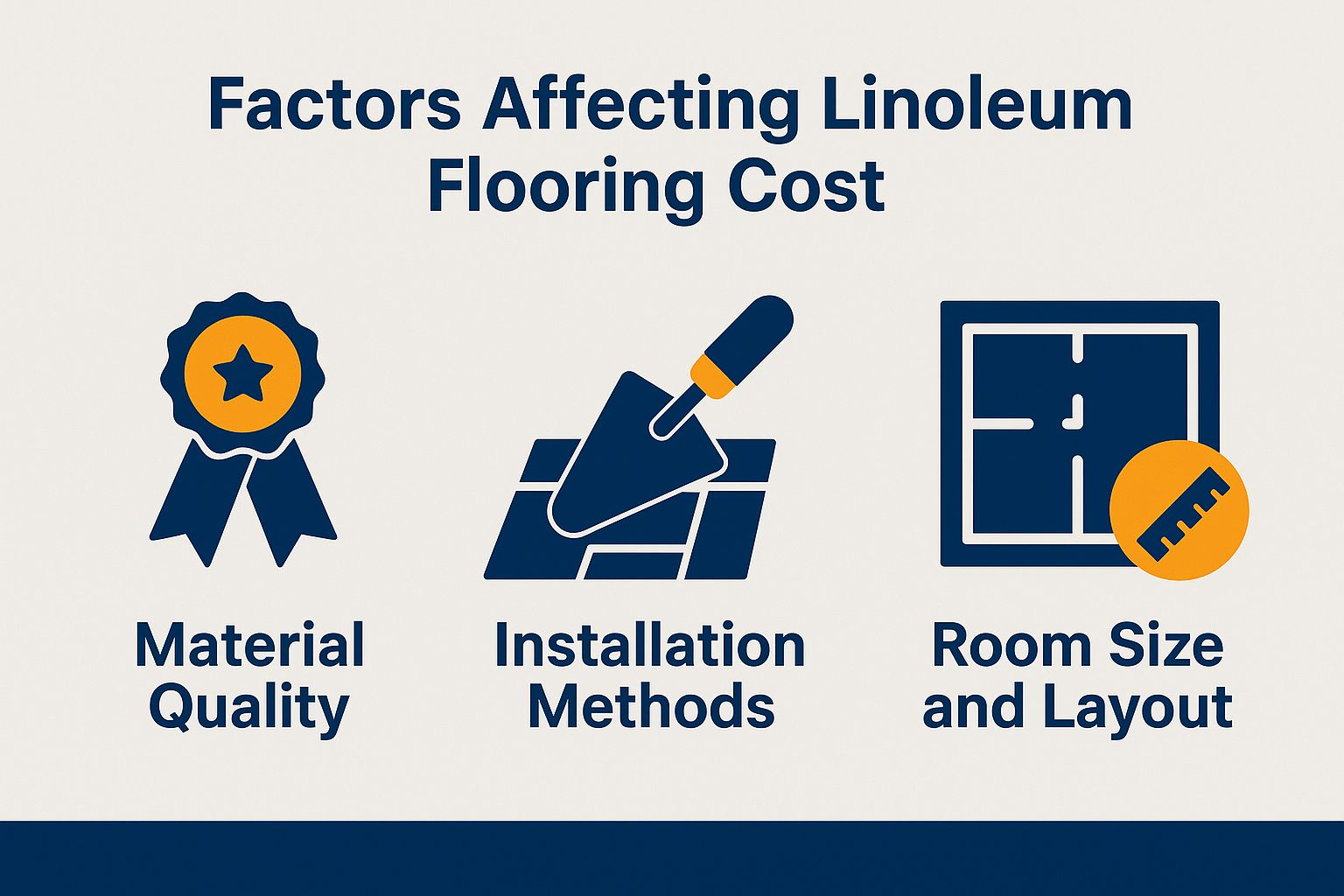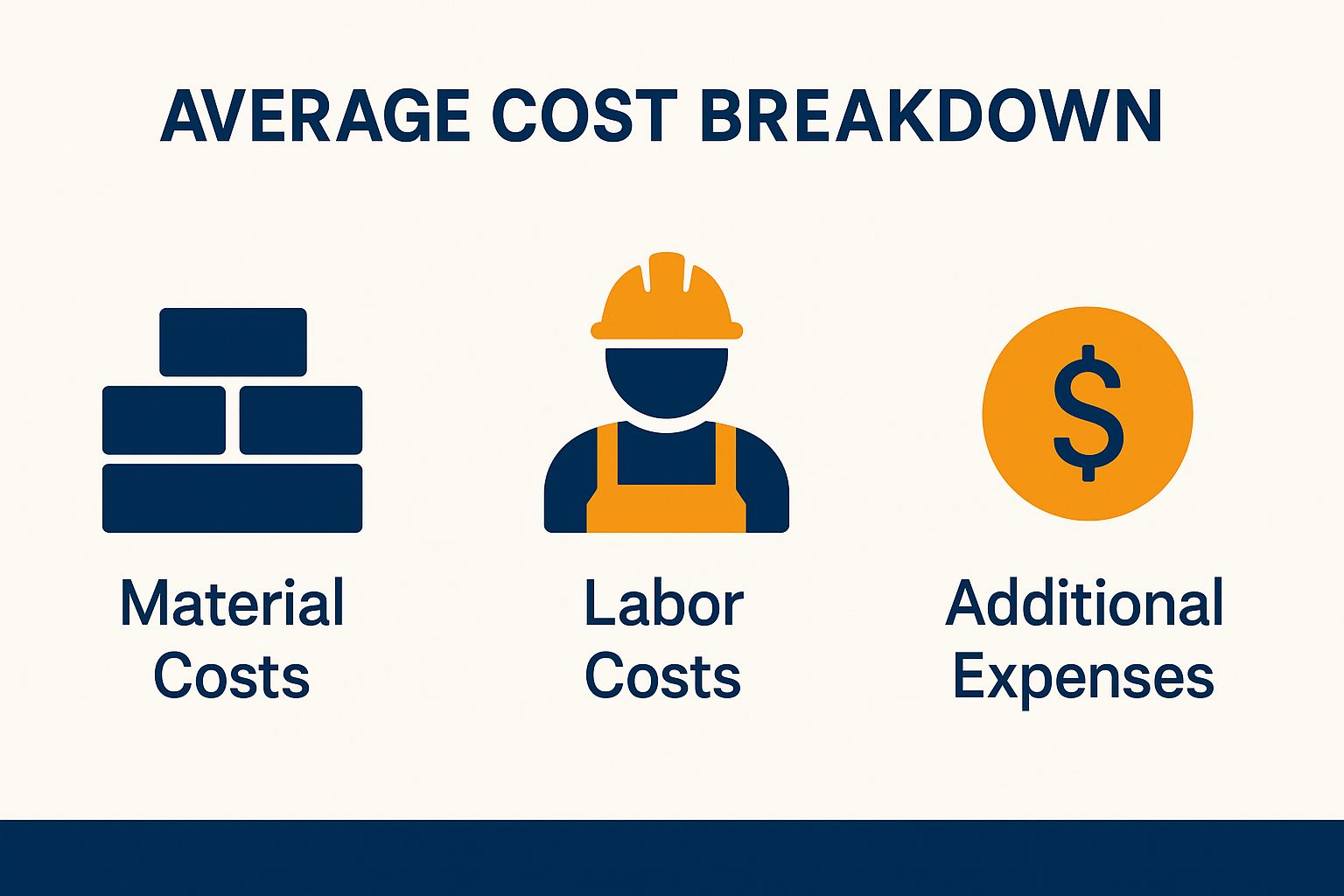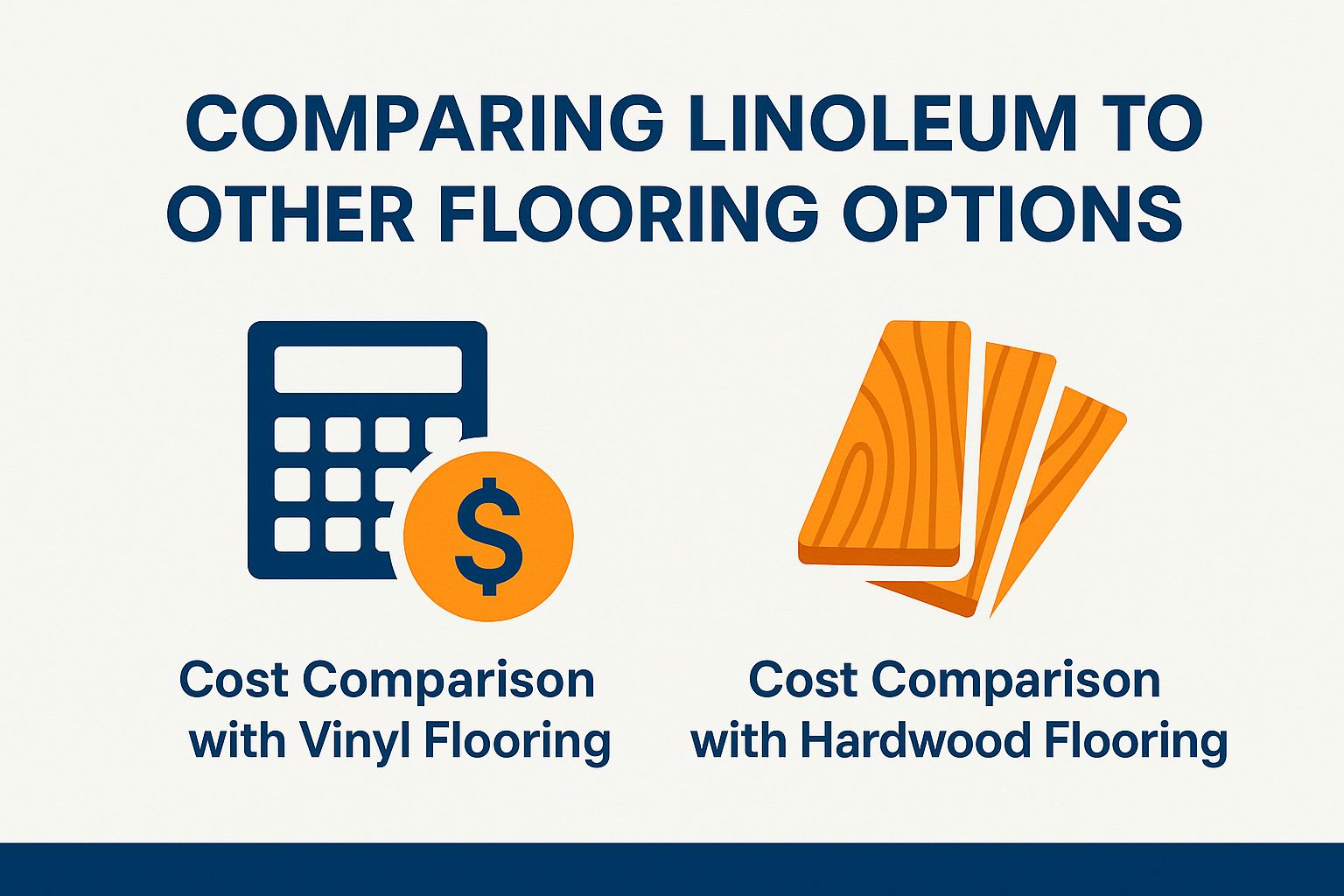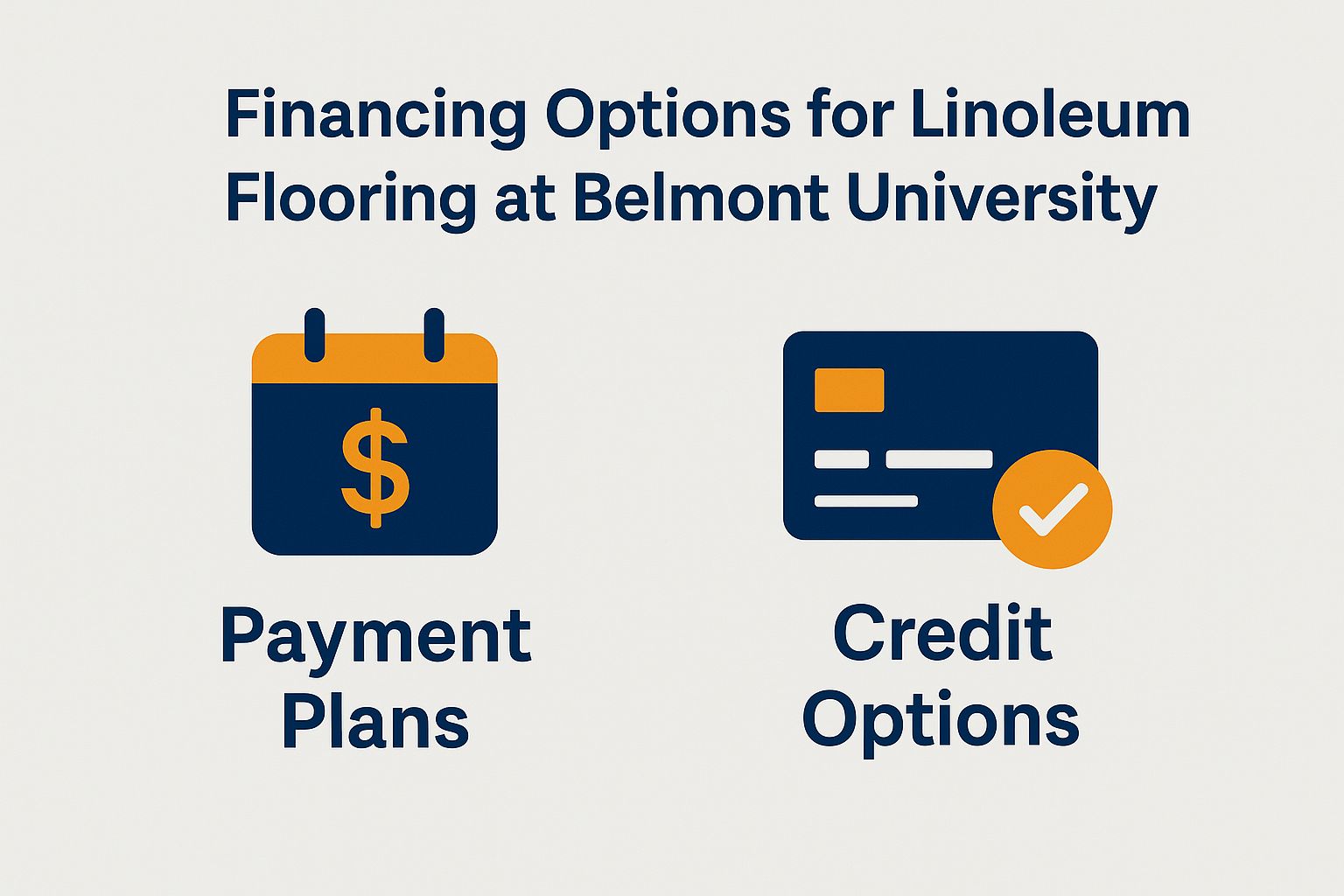
When considering flooring options, linoleum flooring stands out for its affordability, environmental impact, and durability. Frederick Walton popularized linoleum in the 19th century. It has gained popularity in modern design as seen in House Beautiful and ELLE Decor. Experts like Jane Rohde emphasize its eco-friendly linoleum material, making it a smart choice for eco-friendly homeowners. In this article, we’ll explore the pros and cons and the factors affecting linoleum installation costs, helping you make an informed decision for your next flooring project.
What is Linoleum Flooring?
Linoleum is a floor covering composed of natural materials, including linseed oil, jute, and limestone, and was first developed by Frederick Walton in the 1860s. It is recognized for its renewable ingredients and protective coating.
The manufacturing process begins with the oxidation of linseed oil, which is subsequently blended with cork dust, wood flour, and pigments. This mixture is applied to burlap or jute backing. Curing enhances its durability.
Due to its use of natural materials, linoleum offers a range of benefits, including biodegradability and antimicrobial properties, making it an ideal choice for households with allergens. Additionally, frequent cleaning helps enhance its longevity.
In contrast, synthetic vinyl flooring is often cheaper and waterproof. However, it lacks the eco-friendliness and longevity of natural linoleum. It is important to weigh the pros and cons when choosing between these resilient floor coverings.
Therefore, selecting linoleum supports sustainable practices and contributes to a healthier indoor environment, making it a preferred choice for eco-friendly homeowners.
Benefits of Linoleum Flooring
Understanding the pros and cons of linoleum flooring can guide you towards making an informed decision for your home renovation.
Linoleum flooring presents numerous advantages, including its environmentally friendly characteristics, ease of maintenance, and a lifespan of up to 40 years, positioning it as a prudent investment for homeowners. Additionally, its renewable ingredients are key to its sustainability.
Linoleum is durable and made from natural materials like linseed oil and cork dust, which contribute to its minimal environmental impact. This makes it a perfect option for eco-friendly homeowners.
The cleaning process is uncomplicated; regular sweeping and occasional mopping with a damp cloth are typically sufficient for maintaining its appearance. This shows how easy it is to maintain linoleum flooring.
Furthermore, linoleum is available in a wide array of colors and patterns, enabling homeowners to easily coordinate it with their existing decor.
For installation, hire a professional or use a DIY approach. Essential tools include a utility knife and adhesive.
Understanding these features enhances a home’s aesthetic appeal and value.
Factors Affecting Linoleum Flooring Cost
Understanding these factors can help you better plan your home renovation project.
The cost of linoleum flooring is affected by several factors, including the quality of the materials, the methods of installation, and the size and configuration of the room. These factors are crucial for determining overall flooring cost.

Material Quality
Quality significantly affects pricing. Commercial-grade linoleum costs $4 to $8 per square foot, while residential-grade ranges from $2.50 to $5.
Commercial linoleum, such as products from Forbo or Tarkett, is designed to offer enhanced durability and stain resistance, making it particularly suitable for high-traffic areas such as schools and offices. Conversely, residential linoleum is generally thinner and is available in a broader array of colors and patterns, catering to homeowners who seek aesthetic appeal within a budget.
- Factors affecting linoleum flooring cost include:
- Quality of materials influences price.
- Methods of installation
- Size and configuration of the room.
Commercial-grade options:
- $4 to $8 per square foot
- Enhanced durability and stain resistance.
When selecting linoleum, it is essential to consider the intended use of the space. Choose thicker, commercial-grade materials for heavy foot traffic. Residential options work best in low-traffic areas where design matters.
Installation Methods
You can install linoleum yourself or hire a professional. Labor costs range from $1.50 to $5 per square foot based on installation complexity. Platforms like HomeAdvisor and Thumbtack can be useful for finding qualified installers.
For those who choose the DIY approach, essential tools include:
- a utility knife,
- a straight edge,
- and a flooring roller.
Begin by preparing the subfloor. Ensure it’s clean and level before proceeding. Once the preparation is complete, carefully measure and cut the linoleum to fit the designated space, allowing for a small amount of excess material.
If opting for professional installation, get multiple quotes for professional installation. Check each contractor’s experience with linoleum. Analyzing time, skill, and cost in relation to one’s own proficiency can lead to a more informed decision regarding the installation process.
Room Size and Layout
The dimensions and configuration of the installation area significantly impact the costs associated with linoleum flooring. Larger spaces may lead to a reduction in the per-square-foot price due to the advantages of bulk purchasing.
Create a detailed floor plan to measure your room effectively. Use a tape measure for accuracy; one should carefully record the length and width of each section.
It is important to consider waste factors of 10-15% for errors and necessary cuts. Visualize various patterns to minimize waste while enhancing aesthetic appeal.
This careful preparation reduces material costs and ensures a polished finish for your space.
Average Cost Breakdown
Understand the average costs of linoleum flooring. Average costs include materials, labor, and additional fees. For those looking to save on installation, it might be useful to explore options with nearby professionals (our guide to finding vinyl flooring installers near you provides helpful tips). Brands like Forbo and Tarkett offer options for various budgets.

Material Costs
Material costs for linoleum flooring generally range from $2.50 to $8 per square foot, depending on the quality and brand. Compare brands like Armstrong, Congoleum, and Forbo for the best options.
Among the popular linoleum options is Armstrong’s Marmoleum, priced at approximately $4.50 per square foot, recognized for its eco-friendly composition. Another option is Congoleum’s Duracoustic, available at around $3.50 per square foot, which provides superior sound insulation.
Additionally, Forbo’s Linoleum offers a variety of vibrant colors and patterns, starting at $5 per square foot.
When making a selection, it is important to consider factors such as durability and maintenance. Marmoleum exhibits high resistance to wear, making it suitable for various applications, while Congoleum is particularly effective in high-traffic areas.
Ultimately, choose based on your specific needs and budget for long-term satisfaction.
Labor Costs
Labor costs associated with the installation of linoleum flooring can vary considerably, typically ranging from $1.50 to $5 per square foot, depending on the complexity of the project.
Several factors influence these costs, including:
- the experience of the installer, which can lead to significantly higher rates;
- regional pricing differences, as urban areas tend to command higher labor costs;
- the specific requirements of the project, such as subfloor preparation or the removal of existing flooring.
To obtain accurate quotes, it is advisable to contact multiple installers through platforms such as HomeAdvisor or Thumbtack, providing them with detailed information about the size and complexity of the job. This competitive strategy can aid in securing a fair price that is tailored to your particular needs.
Additional Expenses
Additional expenses like underlayment, adhesives, and tools can add $1 to $3 per square foot to the cost of installing linoleum flooring.
Budgeting for these items is crucial for an accurate flooring cost estimate.
Create a comprehensive list of all necessary materials to budget effectively.
- Underlayment costs between $0.50 and $1.50 per square foot.
- Adhesives range from $0.15 to $0.60 per square foot.
- The acquisition of tools, such as a utility knife and a roller, may result in an additional expense of $20 to $50.
Save costs by renting tools instead of buying them. You can also install underlayment yourself to further reduce expenses.
Comparing Linoleum to Other Flooring Options
Compare linoleum with other popular flooring options like vinyl and hardwood based on cost, durability, and aesthetics. Many sources, including Architectural Digest, discuss these comparisons.

Cost Comparison with Vinyl Flooring
When considering vinyl and linoleum, weigh their pros and cons carefully.
Linoleum typically costs between 10-20% less than vinyl flooring, with vinyl priced from $2 to $7 per square foot, while linoleum averages approximately $2.50 to $5 per square foot.
Regarding durability, vinyl flooring is generally more resilient to moisture and dents, making it suitable for high-traffic areas such as kitchens and bathrooms. Linoleum is made from natural materials, making it more environmentally friendly. However, it may need more maintenance to keep its appearance.
In contrast, linoleum is made from natural materials, which makes it more environmentally friendly, though it may require more maintenance to maintain its appearance.
Regarding installation, vinyl flooring often provides convenient peel-and-stick options, making it an appealing choice for do-it-yourself projects, whereas linoleum usually necessitates more detailed installation procedures, including the use of adhesives.
In terms of long-term maintenance, vinyl flooring can have a lifespan of up to 20 years, while linoleum can last about 25 years with proper care. Proper maintenance requirements are crucial to maximize the life span of these materials.
Cost Comparison with Hardwood Flooring
Linoleum flooring generally represents a more budget-friendly option than hardwood flooring, which ranges from $5 to $15 per square foot, not including installation costs. In contrast, linoleum typically costs between $2 and $5 per square foot, making it an attractive choice for renovation projects with budget considerations.
If you want durability and a luxurious look, hardwood flooring is a good choice, especially in high-traffic areas. Conversely, if cost-effectiveness and ease of maintenance are prioritized, linoleum is well-suited for environments such as kitchens and playrooms, where spills and heavy foot traffic are common.
Financing Options for Linoleum Flooring at Belmont University
Financing options for linoleum flooring can alleviate the initial expenses, offering a range of payment plans and credit options for homeowners.

Payment Plans
Many retailers offer flexible payment plans. Homeowners can spread the cost of linoleum flooring over several months with interest rates as low as 0%, as noted by Architectural Digest and ELLE Decor.
To identify and apply for these payment plans, it is advisable to visit the websites of prominent retailers such as Home Depot, Lowe’s, or local flooring companies. It is essential to look for financing options available on their product pages.
For instance, Home Depot offers a credit card option that includes promotional financing for purchases exceeding $299. However, one should be cautious of potential pitfalls like hidden fees or high interest rates after promotional periods.
Review the terms and conditions carefully. Use resources like Credit Karma to compare offers for the best rates.
Credit Options
Home improvement credit cards for flooring often offer features like cashback rewards and deferred interest for up to 12 months.
For instance, the Lowe’s Advantage Card has no interest for six months on purchases over $299. This helps manage larger flooring projects. Similarly, the Home Depot Consumer Credit Card also offers a six-month financing option and a 5% discount on purchases.
Major credit cards like the Chase Freedom card offer rotating 5% cashback on home improvement purchases. This is great for frequent shoppers.
Choosing the right card can reduce expenses and improve flexibility in your home renovation budget.
Frequently Asked Questions
What is the average cost of linoleum flooring?
The average cost of linoleum flooring is between $2 to $5 per square foot. This cost can vary depending on the quality and thickness of the linoleum, as well as the location and labor costs.
What affects the cost of linoleum flooring?
The cost of linoleum flooring can be affected by factors such as the size of the space, the complexity of the installation, the type and quality of linoleum, and the labor costs. Additionally, location can also play a role in the overall cost.
Is linoleum flooring more expensive than other types of flooring?
In general, linoleum flooring tends to be more affordable than other types of flooring, such as hardwood or tile. However, the cost can vary depending on the specific materials and labor costs for each project.
Are there any additional costs to consider when installing linoleum flooring?
Besides materials and labor, consider extra costs when installing linoleum flooring. These can include the cost of underlayment, adhesives, and any necessary equipment or tools for installation.
Can I save money by installing linoleum flooring myself?
You can save money by installing linoleum flooring yourself. However, you need the right knowledge and tools to do so. Improper installation can lead to additional expenses in the long run, so it may be more cost-effective to hire a professional to ensure a proper and long-lasting installation.
Are there any maintenance costs associated with linoleum flooring?
Linoleum flooring requires no special maintenance. Regular cleaning preserves its longevity and appearance.